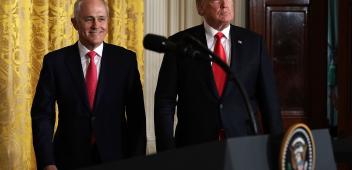What key players want from Trump–Kim talks (and what they’ll get)
Originally published in the South China Morning Post.

The March 9 announcement that the US president had agreed to hold a summit with North Korea’s leader, by South Korean officials speaking on the White House lawn, encapsulated the Trump administration’s chaotic, unorthodox approach to foreign policy. President Donald Trump has by turns threatened and lampooned Kim Jong-un, but always kept the door ajar for a future meeting. Despite his fluctuating rhetoric, that the deal maker-in-chief has opted for the high-stakes gambit of a one-to-one summit to resolve the North Korean nuclear crisis should come as no surprise. It was always on the cards.
The question of what kind of deal, if any, remains wide open. The summit could yet fall through, or slip beyond May. North Korea has offered no comment since the announcement. That should not be surprising either, as Pyongyang has always approached nuclear negotiations with deliberate ambiguity, particularly where the definition of “denuclearisation” is concerned. Kim may still be coming to terms with Trump’s impulsive volleying of the ball back in his court.
On one level, an unprecedented head-to-head with the US president is a long-coveted, status-boosting concession for Pyongyang, one which eluded Kim’s family forebears. A leaders’ summit of such strategic dimensions is normally months if not years in the making. But such a diplomatic escalation on Washington’s part also foreshortens the crunch point at which Pyongyang’s metaphorical nuclear and missile “salami” can no longer be sliced. The fact that Ambassador John Bolton, who is reportedly being considered as a replacement for National Security Adviser H. R. McMaster, has welcomed the summit should give Pyongyang extra pause for thought.
The latest round of musical chairs in the Trump White House has implications for the summit. The decision to shift CIA director Mike Pompeo across to head the State Department, replacing the beleaguered Rex Tillerson, heralds a more hawkish diplomatic line. Differences over North Korea, as well as Iran, were reported to be factors behind Tillerson’s sacking. Pompeo has been closely communicating with South Korea’s head of national intelligence, Suh Hoon, one of President Moon Jae-in’s inter-Korean envoys for the upcoming inter-Korean summit, scheduled in April.
Pompeo believes Washington can still negotiate the North’s complete, verifiable, irreversible, denuclearisation “from a position of enormous strength”. He has also said that Kim is a rational actor. But Pompeo’s reputation as a Trump loyalist points to a concentration of uncontested decision-making power around the president, with few regional experts in a position to make their influence felt on North Korea. With Secretary of Defence James Mattis now perhaps the sole exception in the cabinet, the balance of forces within the administration suggests a more coercive approach – including military options – lies in store, in case the upcoming inter-Korean and US summits fail to produce a breakthrough.
What about the impact on the other key players?
Moon supports the idea of a Trump-Kim summit. By pursuing his own engagement policy with the North, Moon has successfully wrested back some of the initiative on North Korea. Trump’s visit to Seoul and National Assembly speech, last November, reaffirmed South Korea’s centrality as an ally. But Washington still eyes inter-Korean engagement warily, as a distraction from the primary focus on denuclearisation and potentially diluting its “maximum pressure” posture towards Pyongyang.
Moon has successfully interposed himself between Kim and Trump, moving the dial of US–North Korean relations away from confrontation, at least in the short term. Yet Seoul’s occupancy of the driver’s seat is precarious and could be short-lived. The expectation of a US–North Korea summit so close on the heels of an inter-Korean leaders’ meeting puts pressure on Moon to win a substantive commitment on denuclearisation from Pyongyang. Otherwise, Seoul will find itself exposed as Pyongyang’s presumptive emissary and intermediary.
Given North Korea’s ongoing silence, it is not clear if Kim Jong-un’s denuclearisation offer was as clear as South Korea claims. Pyongyang is more likely to define denuclearisation to include the whole of the Korean Peninsula, with the offensive intention of “decoupling” Seoul from Washington’s extended nuclear deterrence framework. What North Korea seeks immediately from a nuclear negotiation with the US is a boost to its status. Beyond its deterrent function, the development of intercontinental nuclear missiles is designed to lure Washington into a peer relationship, compensating for Pyongyang’s legitimacy deficit across every other measure. Hence Foreign Minister Ri Yong-ho voiced North Korea’s desire to establish a “balance of power”, in his address to the UN General Assembly, in September.
Kim has no intention to relinquish the nuclear ace in his pack, but may consider extending a halt on testing beyond the current seasonal pause. Without verification, activity to consolidate progress in the missile and nuclear programmes is bound to continue.
China will be pleased to see the North Korea–US dynamic moving towards talks rather than confrontation, but less happy about being marginalised as a diplomatic bystander, especially given Trump’s initial lean-in towards China. Russia’s role in the North Korean drama, despite sharing a border, is still that of a cameo actor waiting in the wings. President Vladimir Putin has tried to take advantage of Pyongyang’s reluctance to grant an intermediary role to China. Moscow may hope to host Trump and Kim in Vladivostok, to acquire leverage with Washington. But visiting a Russian location would be highly problematic for the US president in other ways.
Japan is highly sceptical of a “premature” Trump–Kim meeting because it sees itself as literally in North Korea’s cross hairs and is concerned that Trump’s desire for a diplomatic success could lead him to override US allies’ interests. Tokyo fears that Pyongyang’s threats against Japan will progressively erode public trust in US security guarantees. Japanese Prime Minister Shinzo Abe will visit Washington in April, as possibly the last foreign leader to speak with Trump before he meets Kim. This will be the greatest test yet of the Japanese prime minister’s alliance management skills.
Can anything positive come out of a Trump–Kim summit, even if the big prize of nuclear disarmament remains out of reach? A moratorium on further ballistic missile and nuclear tests is something the US has negotiated before. Kim would probably demand an adjustment to the US posture on military links with South Korea, in return, but has apparently already conceded the resumption of joint exercises in April. The establishment of a direct US–North Korea military communications channel is one useful objective that would cost both sides little.
Finally, the release of three US citizens held captive in North Korea would present the Trump administration with a domestically popular diplomatic achievement, ahead of the midterm elections.
Trump will hopefully aim higher than this as he frames his objectives for the summit ahead, though not beyond what Kim can realistically accept. Some qualified successes can still be achieved short of complete, verifiable, irreversible disarmament. If the summit collapses with nothing to show for it, this could spell the end of US diplomatic efforts under this administration and hasten the path to war.



